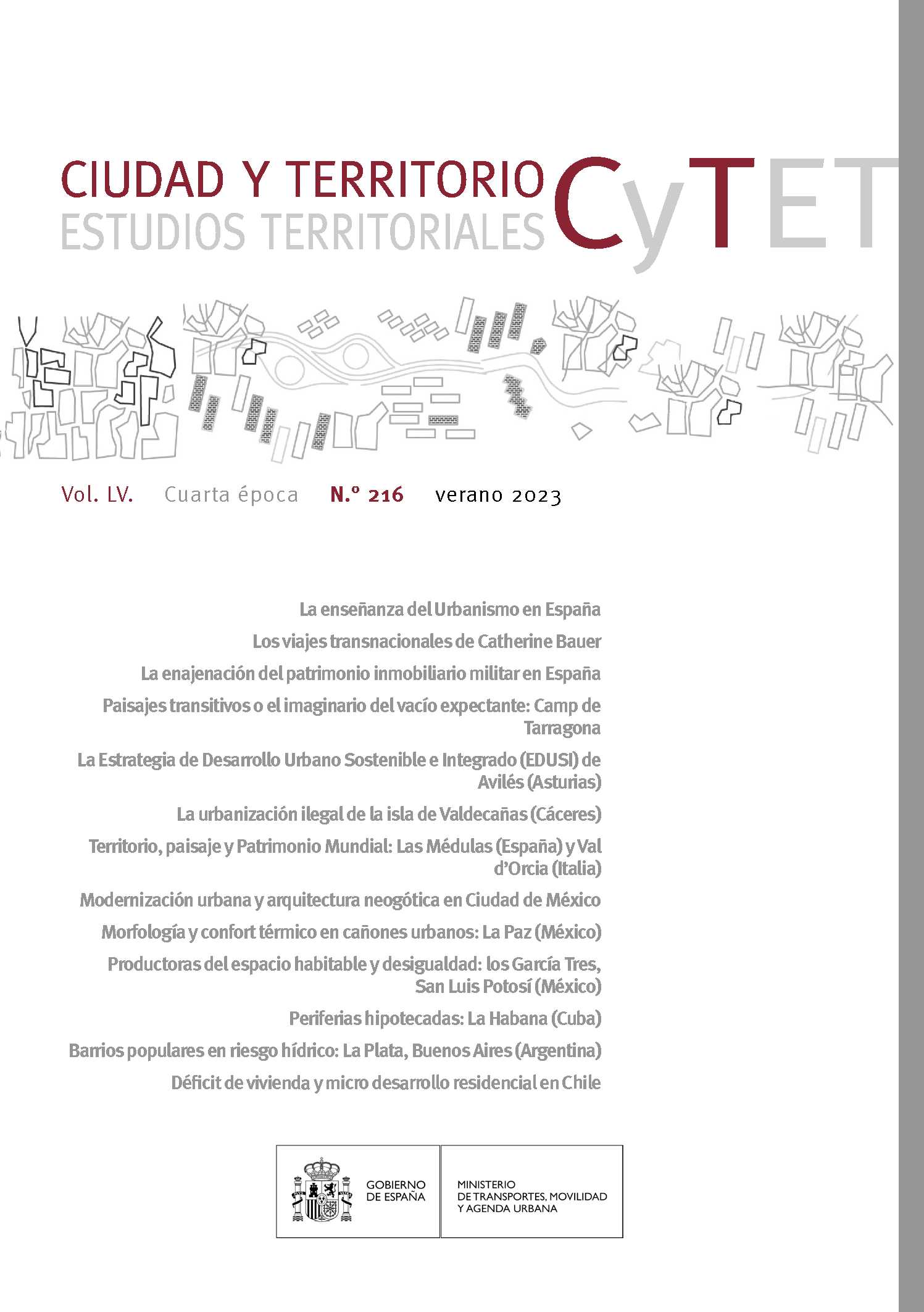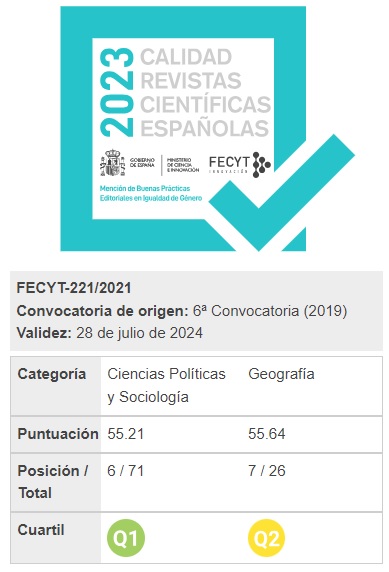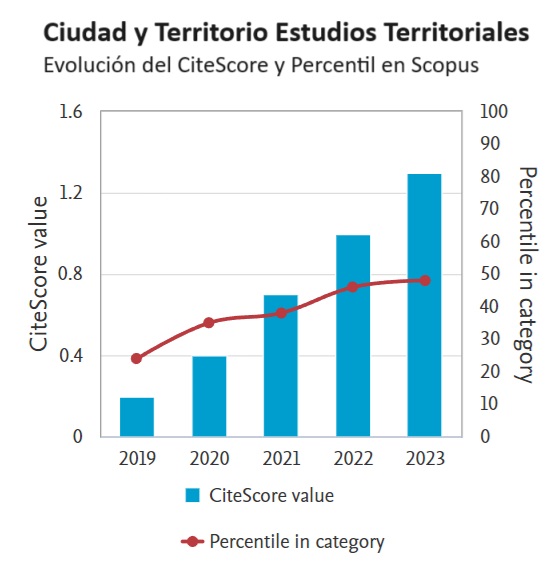The transnational trips of Catherine Bauer: from housing to global planning
DOI:
https://doi.org/10.37230/CyTET.2023.216.2Keywords:
Catherine Bauer, Housing, Planning, Transnational networks, XX CenturyAbstract
This paper focuses on the evolution of the concept of housing through the studio of the issues that enriched the discourse on housing of the pioneering houser Catherine Bauer (1905-1964) in the context of transnational networks. Her name is synonymous with housing in the United States because she devoted her life to improving public housing policies through political and propaganda action. Her transnational trips tell the story of the progression of her ideas, involved meetings, opened labor paths, engendered skills, interests, and wove social networks. They help us understand her affiliation to a group, a field of ideas, which allows us to examine the coherence between his intentions and her actions. The passage from the fragmentary consideration of housing as an architectural object from an aesthetic point of view in the 1920s, the realm of community housing in the 1930s, and after World War II, the holistic synthesis of housing as a socio-economic process, can be glimpsed in the outstanding contributions of his international trips. Her death in 1964 interrupted the discourse.
Downloads
References
Åhrén, U. & Asplund G. & Paulsson, G. & Sundahl, E. & Gahn, W. & Markelius S. (2008): Acceptera. En Creagh, L. & Kåberg, H. & Miller Lane, B. (Eds.). (2008): Modern Swedish Design. Three Founding Texts (140-347). Nueva York, Estados Unidos: Museum of Modern Art. (1ª edición 1931).
Aronovici, C. (1934): America Can’t Have Housing, Nueva York, Estados Unidos, Committee on the Housing Exhibition by the Museum of Modern Art.
Bauer, C. (1928): Machine-Age Mansions for Ultra-Moderns. The New York Times Magazine, 15 de abril, 10-13.
Bauer, C. (1931a): The Americanization of Europe. The New Republic, Volumen LVII, nº 864, 153-154.
Bauer, C. (1931b): Prize Essay: Art in Industry. Fortune, Volumen 3, nº 5, 94-110.
Bauer, C. (1931c): Mr. Wright expresses his personality. Catherine Bauer Wurster papers, BANC MSS 74/163c, The Bancroft Library, Universidad de California, Berkeley.
Bauer, C. (1934a): Housing: Papers Plans or a Workers’ Movement. En America Can’t Have Housing, Nueva York: Committee on the Housing Exhibition by the Museum of Modern, 20-24.
Bauer, C. (1934b): Modern Housing, Nueva York, Estados Unidos: Houghton Mifflin.
Bauer, C. (1934c): British Council Plan is not entirely new. New York Times, 25 de marzo, 5.
Bauer, C. (1934d): Machine-made. The American Magazine of Art, Volumen 27, nº 5, 267-270.
Bauer, C. (1936a): Architecture in Government Housing, Nueva York, Estados Unidos: The Museum of Modern Art.
Bauer, C. (1936b): Elements of English housing practice. En Modern Architecture in England, Nueva York, Estados Unidos, The Museum of Modern Art, 19-24.
Bauer, C. (1936c): Bauer interview. News of the Month, mayo, 341.
Bauer, C. (1937): Art-for-Art’s-Sake. Approach to Architecture no longer possible, says houser. Architectural Record, Volumen 81, nº 1, 8-9.
Bauer, C. (1939): Architectural opportunities in Public Housing. Architectural Record, enero, 65-69.
Bauer, C. (1941): Planned Large-Scale Housing. A balance sheet of Progress. Architectural Record, mayo, 89-105.
Bauer, C. (1943a): Cities in flux: A challenge to the Postward planners. The American Scholar, Volumen 13, nº 1, 70-84.
Bauer, C. (1943b): Review Can Our Cities Survive? By José Luis Sert. Social Service Review, Volumen 17, nº 3, 282-283.
Bauer, C. (1944a): Toward Postwar Housing in the U. S. Transatlantic, nº 16, 35-44.
Bauer, C. (1944b): The County of London Plan: Planning is politics, but are planners politicians? The Architectural Review, Volumen 96, nº 573, 81-82.
Bauer, C. (1944c): Toward a Green and Pleasant England. Critical review of English publications on Postwar Planning. Pencil Points. The Magazine of Architecture, Volumen 78, abril, 94.
Bauer, C. (1945): Good Neighborhoods. The Annals of the American Academy of Political and Social Science, nº 242, 104-115.
Bauer, C. (1946): Garden Cities and the Metropolis: A Reply. The Journal of Land & Public Economics, Volumen 22, nº 1 65-66.
Bauer, C. (1947): Europe vs. America in the Housing Crisis. The Journal of Housing, nº 137, mayo, 154-155.
Bauer, C. (1948): Reconstruction y Reconstruction: France. Task, nº 7-8, 1-6 y 34.
Bauer, C. (1951): Social questions in housing and community planning. Journal of Social Issues, Volumen VII, nº 1-2, 1-34. https://doi.org/10.1111/j.1540-4560.1951.tb02219.x
Bauer, C. (1952): Supertenements: Does the low-income tenant want them? Town and Country Planning, Volumen 10, 458-465.
Bauer, C. (1955): The Architects’ Role in Urban Renewal. Journal of Architectural Education (1947-1974), Volumen 10, nº 1, 37-38.
Bauer, C. (1956): First Job: control the new Urban Sprawl. Forum, septiembre, 105-113.
Bauer, C. (1961): Architecture and the Cityscape. Arts and Architecture. Volumen 78, nº 4, abril, 14-30.
Bauer, C. (1962): The optimum pattern of Urbanization: does Asia need a new type of Regional Planning? Ekistics, Volumen 13, nº 76, 85-89.
Bauer, C. (1964): Can Cities compete with Suburbia for Family Living? Architectural Record, diciembre, 149-156.
Bauer, C. (1965): The Social Front of Modern Architecture in the 1930s. Journal of the Society of Architectural Historians, Volumen 24, nº 1, 48-52. https://doi.org/10.2307/988280
Bauer, C. & Grebler, L. (1952): Review: Two-Thirds of a Nation: A Housing Program by Nathan Strauss. Land Economics, Volumen 28, nº 2, 188-191.
Birch, E. (1978): Woman-Made America. The Case of Early Public Housing Policy. Journal of the American Institute of Planners, Volumen 44, nº 2, 130-144. https://doi.org/10.1080/01944367808976886
Birch, E. (1989): An Urban view: Catherine Bauer’s five questions. Journal of Planning Literature, Volumen 4, nº 3, 239-258. https://doi.org/10.1177/088541228900400301
Caramellino, G. (2012): Planning Note: Negotiating Modern Architecture During the New Deal. Journal of the American Planning Association,8 Volumen 78, nº 4, 376-377. https://doi.org/10.1080/01944363.2012.737975
Cole, S. (1975): Catherine Bauer and the Public Housing Movement, 1926-1932. Tesis doctoral, George Washington University.
Cregah, L. (2011): From acceptere to Vällingby: The Discourse on Individuality and Community in Sweden (1931-54). The European Welfare Statr Project: Ideals, Politics, Cities and Buildings, Volumen 5, nº 2, 5-24.
Ekistics (1965): The human habitat. Ekistics, Volumen 19, nº 112, 138-139.
García-González, M. C. & Guerrero, S. (2017): US contributions to the construction of the modern city: Five women. URBS. Revista de Estudios Urbanos y Ciencias Sociales, Volumen 7, nº 1, 67-87.
Henderson, S. R. (2010): Römerstadt: the modern garden city. Planning Perspectives, 323-346. https://doi.org/10.1080/02665433.2010.481182
Hoffman, A. Von, (2000): A Study in Contradictions: The Origins and Legacy of the Housing Act of 1949. Housing Policy Debate, Volumen 11, nº 2, 299-326.
International Federation for Housing and Town Planning, IFHTP (1946): Papers and report: 18th International Congress for Housing and Town Planning, Hastings, Gran Bretaña: IFHTP.
Kanvinde, A. (Ed.) (1959): Seminar on Architecture, Nueva Delhi, India, Lalit Kala Akademi.
Kwak, N. H. (2012): Planning Note: American Public Housing. Journal of the American Planning Association, Volumen 78, nº 4, 416-417. https://doi.org/10.1080/01944363.2012.737977
Kwak, N. H. (2015): A World of Homeowners American Power and the Politics of Housing Aid, Chicago, Estados Unidos, The University of Chicago Press.
May, E. (1930): Fünf Jahre Wohnungsbautätigkeit in Frankfurt Am Main. Das Neue Frankfurt, Volumen 4, nº 2 y 3, 21-70.
Meyer, A. & Wright, H. & Mumford, L. (1934): New Homes for a New Deal. New Republic, Volumen LXXVIII, 7 marzo, 91-94.
Mumford, E. (2002): The CIAM Discourse on Urbanism, 1928-1960. Cambridge, Estados Unidos: MIT.
Mumford, L. (1932): England two million’s houses, New. Fortune, Volumen 6, nº 11 32-37, 82, 84.
Mumford, L. (1933a): Machines for living. Fortune, Volumen 7, nº 2, 78-80, 82, 84, 87-88.
Mumford, L. (1933b): Taxes into Houses. Fortune, Volumen 7, nº 5, 48-49, 86, 88-90, 92.
Mumford, L. (1946): Garden Cities and the Metropolis: A reply. The Journal of Land & Public Utility Economics, Volumen 22, nº 1, 66-67.
Oberlander H. P. & Newbrun, E. (1999): Houser: The Life and Work of Catherine Bauer, Vancouver, Canadá: University of British Columbia Press.
Penner, B. (2018): The (Still) Dreary Deadlock of Public Housing. Places Journal, octubre. Acceso 28 noviembre 2020. https://doi.org/10.22269/181030
Penner, B. (2020): Prólogo. En Modern Housing, Minesota, Estados Unidos: University of Minnesota Press, I-XLIV.
Pommer R. (1978): The Architecture of Urban Housing in the United States during the Early 1930s. Journal of the Society of Architectural Historians, Volumen 37, nº 4, 235-264.
Rodgers, D. (2000): Atlantic Crossing. Social Politics in a Progressive Age, Cambridge, Estados Unidos: Harvard University Press.
Rodwin, L. (1945): Garden Cities and the Metropolis, The Journal of Land & Public Utility Economics, Volumen 21, nº 3, 268-81. https://doi.org/10.2307/3159217
Rudberg, E. (2017): A tribute to the Memory of Sven Markelius and Uno Åhrén, Estocolmo, Suecia: Royal Swedish Academy of Engineering Sciences.
Sandeen, E. (1985): The Design of Public Housing in the New Deal: Oskar Stonorov and the Carl Mackley Houses. American Quarterly, Volumen 37, nº 5, 645–667.
Scott, M. (1969): American City Planning since 1890, Berkeley, Estados Unidos, University of California Press.
Shoshkes, E. (2006): Jaqueline Tyrwhitt: a founding mother of urban design. Planning Perspectives, Volumen 21, nº 2, 179-197.
Shoshkes, E. (2010): Martin Meyerson and Jaqueline Tyrwhitt and the Global Exchange of Planning Ideas. Journal of Planning History, Volumen 9, nº 2, 75-94.
Spann, E. K. (1996): Designing Modern America. The Regional Planning Association of America and Its Members, Ohio, Estados Unidos: Ohio University Press.
The Architectural Forum (1946): Housing’s white knight. The Architectural Forum, marzo, 117-119 y 146-150.
Tostrup, E. (1997): The influence of the 1930 Stockholm Exhibition on the Development of Functionalism and Modernism in Norwegian Post-war Architecture. Nordisk Arkitektur forskning, nº 4, 63-75.
Turner, R. (1962): India's urban future; selected studies from an international conference sponsored by Kingsley Davis, Richard L. Park [and] Catherine Bauer Wurster, Berkeley, Estados Unidos: University of California Press.
Wood, E. E. (1923): Housing Progress in Europe, Nueva York, Estados Unidos: E. P. Dutton and Company, 1923.
Woudstra, R. (2018): Exhibiting Reform: MoMA and the Display of Public Housing (1932-1939). Architectural Histories, Volumen 6, nº 1. https://doi.org/10.5334/ah.269
Wojtowicz, R. (2001): Frank Lloyd Wright & Lewis Mumford: Thirty Years of Correspondence, Nueva York, Estados Unidos: Princeton Architectural Press.
Wright, G. (1995): A Partnership: Catherine Bauer and William Wurster. En Marc Trieb, (Ed.), An Everyday Modernism: The Houses of William Wurster, Berkeley, Estados Unidos: University of California Press.
Wright, G. (2004): Design and Affordable American Housing. Cityscape, Volumen 16, nº 269-86.
Wurster, W. (1958): Row House vernacular and High Style Monument. Architectural Record, agosto, 141-150.
Wurster, W. & Bauer, C. (t): Indian Vernacular Architecture: Wai and Cochin. Perspecta, nº 5, 37-48.
Published
How to Cite
Issue
Section
License
Copyright (c) 2023 María Cristina García-González, Salvador Guerrero

This work is licensed under a Creative Commons Attribution-NonCommercial-NoDerivatives 4.0 International License.
Considering the provisions of the current legislation on Intellectual Property, and in accordance with them, all authors publishing in CyTET give -in a non-exclusive way and without time limit- to the Ministry of Transport, Mobility and Urban Agenda the rights to disseminate, reproduce, communicate and distribute in any current or future format, on paper or electronic, the original or derived version of their work under a Creative Commons Attribution-NonCommercial-NoDerivative 4.0 license International (CC BY-NC-ND 4.0), as well as to include or assign to third parties the inclusion of its content in national and international indexes, repositories and databases, with reference and recognition in any case of its authorship.
In addition, when sending the work, the author(s) declares that it is an original work in which the sources that have been used are recognized, committing to respect the scientific evidence, to no longer modify the original data and to verify or refute its hypothesis. Author(s) also declare that the essential content of the work has not been previously published nor will it be published in any other publication while it is under evaluation by CyTET; and that it has not been simultaneously sent to another journal.
Authors must sign a Transfer of Rights Form, which will be sent to them from the CyTET Secretariat once the article is accepted for publication.
With the aim of promoting the dissemination of knowledge, CyTET joins the Open Journal Access (OA) movement and delivers all of its content to various national and international indexes, repositories and databases under this protocol; therefore, the submission of a work to be published in the journal presupposes the explicit acceptance by the author of this distribution method.
Authors are encouraged to reproduce and host their work published in CyTET in institutional repositories, web pages, etc. with the intention of contributing to the improvement of the transfer of knowledge and the citation of said works.








 Enlace a CyTET en Linkedin
Enlace a CyTET en Linkedin